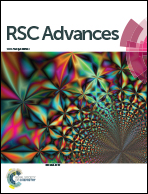Three-dimensional hierarchical self-supported NiCo2O4/carbon nanotube core–shell networks as high performance supercapacitor electrodes†
Abstract
A three-dimensional (3D) hierarchical self-supported NiCo2O4/carbon nanotubes/nickel foam (NiCo2O4/CNT/NF) electrode has been developed by electrodepositing NiCo layered double hydroxides (LDHs) on a self-supported CNT layer grown on a macroporous NF substrate followed by a simple post-annealing process. The resulting 3D hierarchical self-supported NiCo2O4/CNT/NF electrode delivered high specific capacitances of 1533 F g−1 and 1335 F g−1 at current densities of 3 A g−1 and 30 A g−1, respectively, vastly superior to those of a NiCo2O4/NF electrode at the same current density. The NiCo2O4/CNT/NF electrode also had good cycling stability and showed 102% initial capacitance retention after 2500 cycles at progressively varying current densities. The performance of the NiCo2O4/CNT/NF electrode was further evaluated by a two-electrode asymmetric supercapacitor device. The asymmetric device delivered a high energy density of 48.3 W h kg−1 at a power density of 799.9 W kg−1 and still maintained an energy density of 17.1 W h kg−1 as the power density increased up to 7995 W kg−1. Remarkably, the asymmetric device also exhibited good cycling stability with capacitance retention of 78.9% after 2000 cycles at a current density of 2 A g−1, indicating promising applications in supercapacitors. The results of this study also provide an alternative strategy for constructing high performance supercapacitor electrodes with high specific capacitance, good rate capability and cycling stability.


 Please wait while we load your content...
Please wait while we load your content...